Suchindram is a popular place in any religious travel circuit of the
far South. Being only 12 kms from Kanyakumari, it is an easy detour for many pilgrims. But for
me arrival into Suchindram is quite different. Today there is a statewide strike in Kerala. There
were no buses from the capital. It didn’t matter since I had planned on catching a train. I got a
passenger train fromThiruvananthapuram to Nagercoil, where I dumped my backpack at the
station’s cloak room. From Nagercoil, Suchindram is a short bus ride.
far South. Being only 12 kms from Kanyakumari, it is an easy detour for many pilgrims. But for
me arrival into Suchindram is quite different. Today there is a statewide strike in Kerala. There
were no buses from the capital. It didn’t matter since I had planned on catching a train. I got a
passenger train fromThiruvananthapuram to Nagercoil, where I dumped my backpack at the
station’s cloak room. From Nagercoil, Suchindram is a short bus ride.
Suchindram is one of those little towns of Tamil Nadu that hold little interest to a tourist except
for one magnificent temple. Such places are what I would call temple towns. While places like
Bhubaneshwar or Khajuraho are packed with temples, a temple town of Tamil Nadu is a
special place. It preserves much of its medieval appeal. I have come to savour a little bit of that.
for one magnificent temple. Such places are what I would call temple towns. While places like
Bhubaneshwar or Khajuraho are packed with temples, a temple town of Tamil Nadu is a
special place. It preserves much of its medieval appeal. I have come to savour a little bit of that.
I have never heard of the temple’s name. It is enough to called it the ‘Temple of Suchindram.’
As usual, there are a number of different historical and place names for this temple, including
Suchindram Thanumalaya Temple, Sri Sthanumalaya Perumal Swamy Temple, and Arulmigu
Thanumalayar Temple.
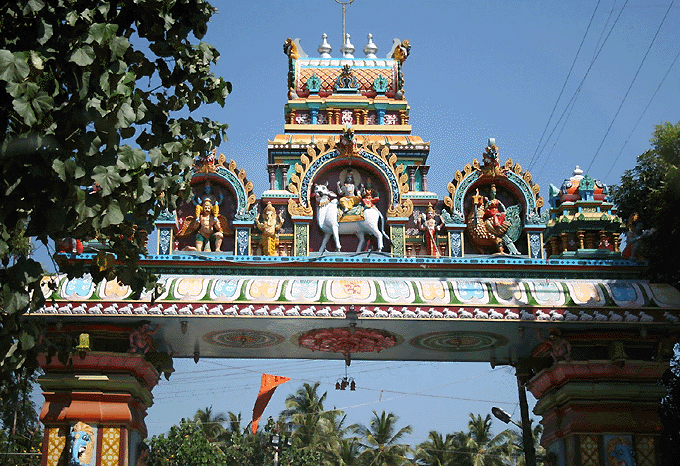
As usual, there are a number of different historical and place names for this temple, including
Suchindram Thanumalaya Temple, Sri Sthanumalaya Perumal Swamy Temple, and Arulmigu
Thanumalayar Temple.

Temple gateway
It is only later I learn that the temple enshrines Thanumalayan, a linga that can be considered to
be a union of the Hindu Trinity – sthanu for Shiva, mal for Vishnu and ayan for Brahma. If this be
A large temple tank spreads out to the right, with the towering gopuram ahead.
134 feet in height, the seven-storied construction is an excellent example of
classic South Indian temple architecture. The (usually) unpainted stone gopuram is intricately
It is only later I learn that the temple enshrines Thanumalayan, a linga that can be considered to
be a union of the Hindu Trinity – sthanu for Shiva, mal for Vishnu and ayan for Brahma. If this be
A large temple tank spreads out to the right, with the towering gopuram ahead.
134 feet in height, the seven-storied construction is an excellent example of
classic South Indian temple architecture. The (usually) unpainted stone gopuram is intricately
and amazingly carved into thousands of high relief, exquisitely rendered images of deities,
transcendental pastime scenes , and various 9th century inscriptions. The play of light on the
multi-faceted gopuram makes it a brilliant and beautiful structure.It is a short walk from the road
into the town of Suchindram. I pass under a colourful painted gateway. Deities sit in canopied
aedicules over the gateway. A mini-gopuram in traditional Tamil style crowns the gateway.
There is no traffic, no bustling movement of pilgrims in their hurry for darshan in a never ending
ritual of temple hopping. A bright yellow auto-rickshaw waits for business. A cyclist pedals so
leisurely that I feel his rhythm is in tune with the mood of the morning.
transcendental pastime scenes , and various 9th century inscriptions. The play of light on the
multi-faceted gopuram makes it a brilliant and beautiful structure.It is a short walk from the road
into the town of Suchindram. I pass under a colourful painted gateway. Deities sit in canopied
aedicules over the gateway. A mini-gopuram in traditional Tamil style crowns the gateway.
There is no traffic, no bustling movement of pilgrims in their hurry for darshan in a never ending
ritual of temple hopping. A bright yellow auto-rickshaw waits for business. A cyclist pedals so
leisurely that I feel his rhythm is in tune with the mood of the morning.
I spot the temple’s seven-tiered gopuram from a distance. The gopuram is white washed
without highlights. It is packed with details. Although it stands on a stone base, I find it difficult to
make out if the rest of it is made of stone or cement or Other. The distemper hides its real
character but maintains the impressive structure well. It would take hours to appreciate all the
scenes on the gopuram. It is really a representation of heaven itself. The gods and goddess,
and the stories they play out, dramatize familiar tales of Hindu mythology. Dwarapalakas guard
the seven entrances on the broad faces of the gopuram. Mount Meru plays anchor as gods and
demons churn the ocean for nectar. Indra rides on his elephant. Other deities sit majestically on
their respective vehicles. Multi-headed and multi-armed deities are simply a window to the vast
imagination and beliefs of those who collectively created Hinduism.
without highlights. It is packed with details. Although it stands on a stone base, I find it difficult to
make out if the rest of it is made of stone or cement or Other. The distemper hides its real
character but maintains the impressive structure well. It would take hours to appreciate all the
scenes on the gopuram. It is really a representation of heaven itself. The gods and goddess,
and the stories they play out, dramatize familiar tales of Hindu mythology. Dwarapalakas guard
the seven entrances on the broad faces of the gopuram. Mount Meru plays anchor as gods and
demons churn the ocean for nectar. Indra rides on his elephant. Other deities sit majestically on
their respective vehicles. Multi-headed and multi-armed deities are simply a window to the vast
imagination and beliefs of those who collectively created Hinduism.
Everything around the temple is so still. I feel I have come at the best possible time. I am seeing
Suchindram in its essential element without intruding tourists, passing pilgrims or itinerant
vendors.Clouds drift leisurely. Often they seem to hover in the distance as they pass the
gopuram. The gopuram dazzles the eye in its brightness in the harsh sun. A lone coconut tree
near the gopuram sways in a steady breeze. With each movement of its fronds it highlights the
solidity and loftiness of the gopuram. Outside, a large stepped tank lies quietly. The breeze
ruffles the water’s surface. At its center is a pillared mandapa, crowned by a vimana in
Dravidian style. Women are washing clothes or bathing in the margins of the tank. Houses
crowd the tank on two of its sides. The temple wall, coloured in vertical bands of white and red,
lines the tank on the third side across a narrow road.
Suchindram in its essential element without intruding tourists, passing pilgrims or itinerant
vendors.Clouds drift leisurely. Often they seem to hover in the distance as they pass the
gopuram. The gopuram dazzles the eye in its brightness in the harsh sun. A lone coconut tree
near the gopuram sways in a steady breeze. With each movement of its fronds it highlights the
solidity and loftiness of the gopuram. Outside, a large stepped tank lies quietly. The breeze
ruffles the water’s surface. At its center is a pillared mandapa, crowned by a vimana in
Dravidian style. Women are washing clothes or bathing in the margins of the tank. Houses
crowd the tank on two of its sides. The temple wall, coloured in vertical bands of white and red,
lines the tank on the third side across a narrow road.
I walk around the temple passing many traditional houses. It is a common
Tamil ritual to draw floral or geometric designs in front of houses. In the mornings, the space is
swept clean and sprinkled with water. With just white rice powder, Tamil women expertly draw
these complex designs in a matter of minutes. On special occasions, bigger and more
colourful designs may be created. These are called kolams.
Tamil ritual to draw floral or geometric designs in front of houses. In the mornings, the space is
swept clean and sprinkled with water. With just white rice powder, Tamil women expertly draw
these complex designs in a matter of minutes. On special occasions, bigger and more
colourful designs may be created. These are called kolams.
That feeling of timelessness lingers as you enter the temple, with only your senses to witness
the wonders within. You have to leave your camera — and if you’re a male your shirt — and
other trappings of the modern world at the door.
‘Is this Vishnu?’ a tourist from North India quizzes me. From the markings on his forehead and
the prasad in his palms, I notice that he has already finished his darshan without really knowing
who or what.
the wonders within. You have to leave your camera — and if you’re a male your shirt — and
other trappings of the modern world at the door.
‘Is this Vishnu?’ a tourist from North India quizzes me. From the markings on his forehead and
the prasad in his palms, I notice that he has already finished his darshan without really knowing
who or what.
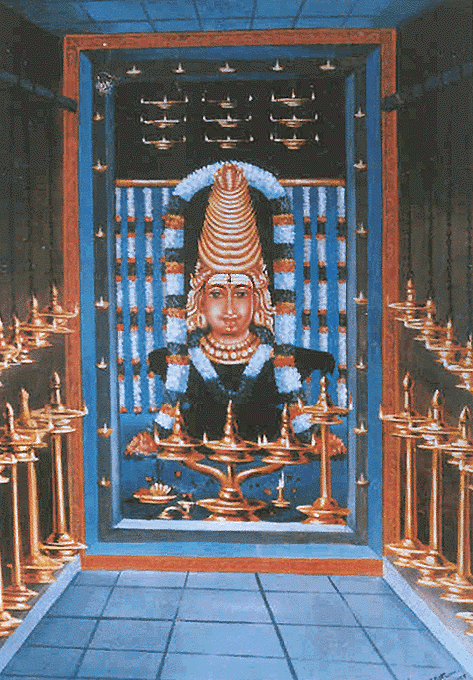
Sri Sthanu Malaya Perumal Swamy
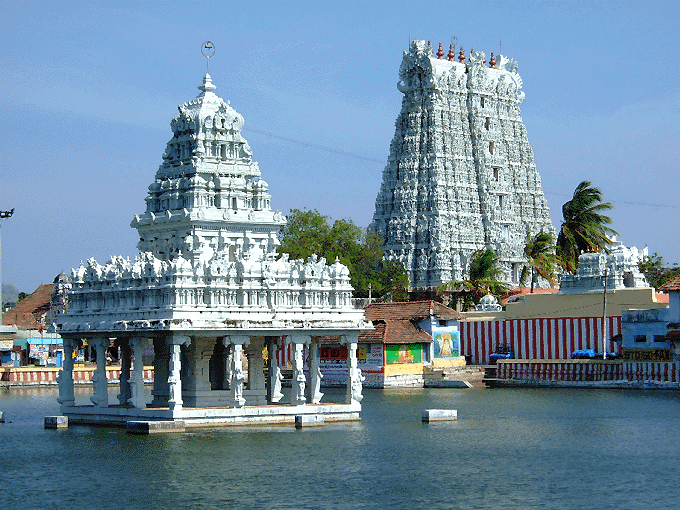
Suchindram Temple and Tank
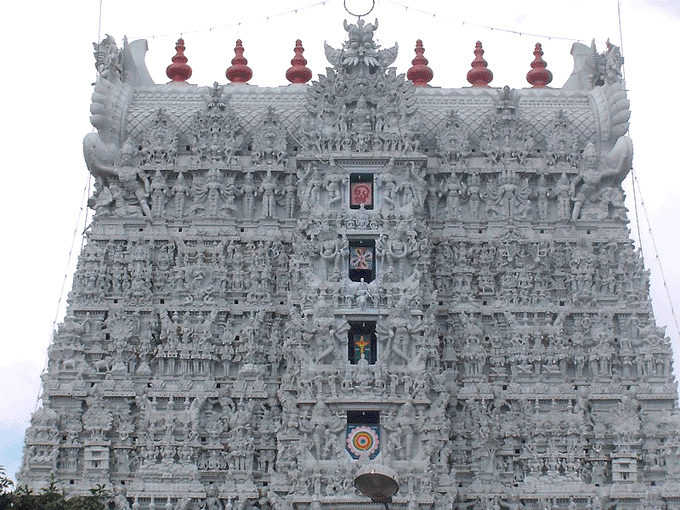
Top of gopuram
Both Vaishnavas and Shaivites flock to this temple, which has a rich Puranic history, including
an interesting pastime involving Lord Brahma. The Sage Atri lived here with his wife Anusuya,
who was considered a very chaste woman. Lord Brahma, Siva, and Vishnu visited her once
during the absence of her husband, hoping to test and prove her chastity. They arrived as
sannyasis asking alms and begged Anusuya to feed them, but told her that they had taken a
vow under which they could not accept alms from a person wearing clothes. It was a sin to
refuse alms to mendicants, but the chaste Anusuya was not baffled. She simply offered prayers
on the matter, then sprinkled paatha theerthamon the three beggars, transforming them into
three small babies. She then disrobed and feed them.
an interesting pastime involving Lord Brahma. The Sage Atri lived here with his wife Anusuya,
who was considered a very chaste woman. Lord Brahma, Siva, and Vishnu visited her once
during the absence of her husband, hoping to test and prove her chastity. They arrived as
sannyasis asking alms and begged Anusuya to feed them, but told her that they had taken a
vow under which they could not accept alms from a person wearing clothes. It was a sin to
refuse alms to mendicants, but the chaste Anusuya was not baffled. She simply offered prayers
on the matter, then sprinkled paatha theerthamon the three beggars, transforming them into
three small babies. She then disrobed and feed them.
The Goddesses Saraswati, Laksmi and Parvati then intervened, and the three babies were
restored to their normal forms. As the divine personalities departed, the deities remained
behind, manifesting in the form of Swayambulingas, which sprouted under an Amaltas tree.
This tree, the Sthala Vriksham, has been dated to approximately 2,500 years old. The tree is
now decaying and hollow, and it has been preserved by a meticulous metal plating. Within the
hollow trunk are the three separate linga, for Lord Brahma, Lord Visnu, and Lord Shiva. A
small and beautiful shrine known as Konnayadi has been constructed in front of the Vriksham,
which sits nearby the Nandi shrine.
The temple construction took place over an extended period of at least six hundred years, so
parts of the temple date back to the late 8th century, while others are 15th century. The earliest
lithic records of Suchindram belong to the 9th Century A.D. Up until the time Kanyakumari
became part of Tamil Nadu, the Suchindram Temple was under the administration of the
Travancore Kings. Travancore at that time had its main temple at Padmanabhapuram, which
was Vaishnavite. The Nanjil Pillais and other community members in Nagarcoil were primarily
Shaivaites, probably due to influences from the Chola, Chera and Pandya kingdoms before the
advent of Travancore kingdom. One of the unique aspects of Sichindram Temple is the
presence of deities from all the religious sects: Vaisnava, Shaivita, and local Tamil cults like
Amman and Kandan. Temple worship, however, is controlled by one of the main Namboodiri
Braman families, the Thekkumon Madam.
restored to their normal forms. As the divine personalities departed, the deities remained
behind, manifesting in the form of Swayambulingas, which sprouted under an Amaltas tree.
This tree, the Sthala Vriksham, has been dated to approximately 2,500 years old. The tree is
now decaying and hollow, and it has been preserved by a meticulous metal plating. Within the
hollow trunk are the three separate linga, for Lord Brahma, Lord Visnu, and Lord Shiva. A
small and beautiful shrine known as Konnayadi has been constructed in front of the Vriksham,
which sits nearby the Nandi shrine.
The temple construction took place over an extended period of at least six hundred years, so
parts of the temple date back to the late 8th century, while others are 15th century. The earliest
lithic records of Suchindram belong to the 9th Century A.D. Up until the time Kanyakumari
became part of Tamil Nadu, the Suchindram Temple was under the administration of the
Travancore Kings. Travancore at that time had its main temple at Padmanabhapuram, which
was Vaishnavite. The Nanjil Pillais and other community members in Nagarcoil were primarily
Shaivaites, probably due to influences from the Chola, Chera and Pandya kingdoms before the
advent of Travancore kingdom. One of the unique aspects of Sichindram Temple is the
presence of deities from all the religious sects: Vaisnava, Shaivita, and local Tamil cults like
Amman and Kandan. Temple worship, however, is controlled by one of the main Namboodiri
Braman families, the Thekkumon Madam.
There rare female form of Vinayaka (Ganesha) here is known as Vigneshwari, or Vallabha
Ganeshaani, as described in the Mantra Shastras. This Ganeshaani murti in sukhasana pose
at Suchindram is one of only a few, the others being at a 10th century temple dedicated to 64
yoginis in Bheraghat, near Jabalpur, and one at the Tanumalaya Swami Temple in Suchindrum,
Kerala. In Tibet, this female form of Ganesh is worshiped as Gajanani.
Ganeshaani, as described in the Mantra Shastras. This Ganeshaani murti in sukhasana pose
at Suchindram is one of only a few, the others being at a 10th century temple dedicated to 64
yoginis in Bheraghat, near Jabalpur, and one at the Tanumalaya Swami Temple in Suchindrum,
Kerala. In Tibet, this female form of Ganesh is worshiped as Gajanani.
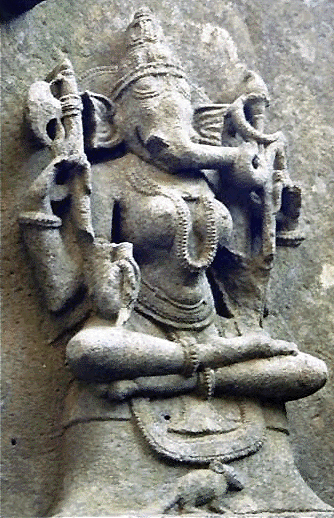
Vallabha Ganeshaani
In front of this shrine dedicated to Ganesha, is an intimate mandapa housing the Navagrahas.
The mandapa ceiling is panelled and each panel has beautiful reliefs symbolic of the nine
planets. I find many devotees going round the images of the Gods who personify the nine
planets.
The mandapa ceiling is panelled and each panel has beautiful reliefs symbolic of the nine
planets. I find many devotees going round the images of the Gods who personify the nine
planets.
The main shrine is dedicated to Shiva in linga form. Behind this is another shrine dedicated to
Vishnu.Outside the main mandapa is a shrine dedicated to Brahma. I am informed that the
Creator’s shrine is woodwork gilded in gold. Nearby is a wonderful sculpture of Garuda. One
pillar relief is a beautiful image of Vigneshwari, Ganesha in his female form. In another part of
the temple is an 18-foot black stone idol of Hanuman. He appears to be a popular object of
worship.
Vishnu.Outside the main mandapa is a shrine dedicated to Brahma. I am informed that the
Creator’s shrine is woodwork gilded in gold. Nearby is a wonderful sculpture of Garuda. One
pillar relief is a beautiful image of Vigneshwari, Ganesha in his female form. In another part of
the temple is an 18-foot black stone idol of Hanuman. He appears to be a popular object of
worship.
Every pillar is designed and crafted based on rules and principles, many of which contain much
religious symbolism. The mouldings of lotuses are exactly the same as those in
Thiruvananthapuram.
Another thing to note is that Suchindram was in fact part of the erstwhile kingdom of
Travancore.The same artists may have worked on both the temples. Even today, I find many
people speaking in Malayalam. Even those who speak in Tamil, have an accent that bears
similarity to Malayalam.
This temple is famed for its musical pillars. These are two composite pillars facing the Shiva
shrine. Elsewhere are four composite pillars collectively defining a space called the Alankara
Mandapa. These composite pillars contain slender stone columns that produce distinct notes
when struck. I give it a try. No sound comes out. A priest comes along with a band of tourists. I
see that to produce any sound one has to hit hard, hit it with the bone. In one composite pillar, I
count as many as 12 slender columns. Some of these pillars are caged off to preserve them
from vandalism.
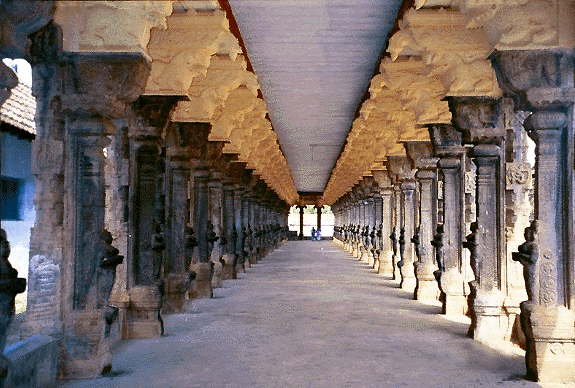
shrine. Elsewhere are four composite pillars collectively defining a space called the Alankara
Mandapa. These composite pillars contain slender stone columns that produce distinct notes
when struck. I give it a try. No sound comes out. A priest comes along with a band of tourists. I
see that to produce any sound one has to hit hard, hit it with the bone. In one composite pillar, I
count as many as 12 slender columns. Some of these pillars are caged off to preserve them
from vandalism.
There are another 1,035 carved pillars in what's known as the dancing hall.

In one corner is the Oonjal Mandapam. The pillars contain wonderful reliefs. A few pillars in the
Chitra Sabha near the exit have equally fascinating stone sculptures. This gallery contains
modern paintings on its walls. The paintings depict different forms of Shiva’s cosmic dance, the
Tandava. The usual pose of Shiva is the Ananda Tandava but this gallery tells about fifteen
other types of tandava poses.
Elsewhere are wall murals in the Keralan style. They are however very few in number and not
well-preserved as in the temples of Kerala.
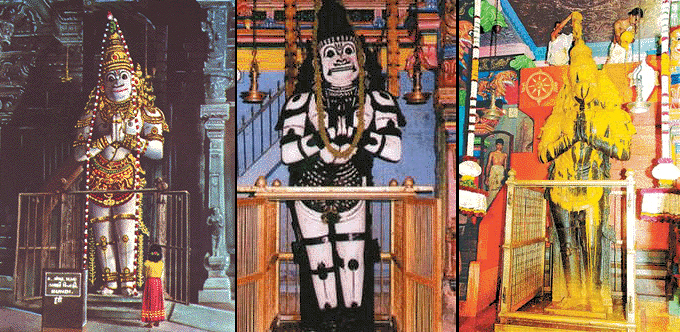
Sri Hanuman in various veshas
Chitra Sabha near the exit have equally fascinating stone sculptures. This gallery contains
modern paintings on its walls. The paintings depict different forms of Shiva’s cosmic dance, the
Tandava. The usual pose of Shiva is the Ananda Tandava but this gallery tells about fifteen
other types of tandava poses.
Elsewhere are wall murals in the Keralan style. They are however very few in number and not
well-preserved as in the temples of Kerala.
Today, temple priests offer Hanuman puja with milk, sandalwood paste and kum kum, climbing
a staircase to arrive at Hanuman's face. The deity is sometimes covered in butter and Vadai
garlands. Hanuman's pose in this murti, with folded hands, is likely him tanding before Mother
Sita in Ashoka Vanam.
a staircase to arrive at Hanuman's face. The deity is sometimes covered in butter and Vadai
garlands. Hanuman's pose in this murti, with folded hands, is likely him tanding before Mother
Sita in Ashoka Vanam.

Sri Hanuman in various veshas
One of the historic treasures of the temple are some Pali inscriptions from the 3rd century BC.
These are sure proofs of the vast extent of the Mauryan Empire. In my excitement with the
sculptures and musical pillars, I completely forget about these inscriptions. Had I remembered, I
would have asked one of the priests to show me these stone writings of ancient India.
These are sure proofs of the vast extent of the Mauryan Empire. In my excitement with the
sculptures and musical pillars, I completely forget about these inscriptions. Had I remembered, I
would have asked one of the priests to show me these stone writings of ancient India.
The same garrulous priest with his band of obedient tourists comes around again. He takes
them to a tall dwarapalaka sculpted in stone. He takes a thin stem of a coconut leaf and
threads it right through from one ear to the other. It highlights the artistic excellence of the
sculptor who created it. The dwarapalaka does not listen to these trivialities. His job is only to
guard the entrance.
For you are immediately drawn to the fleet of exquisitely carved, wooden temple cars standing
sentinel around the temple. A couple of them are large, massive even, and look like they’ve
rolled in from another, timeless world. And perhaps they have, for they carry the gods during the
temple’s annual festival in December.
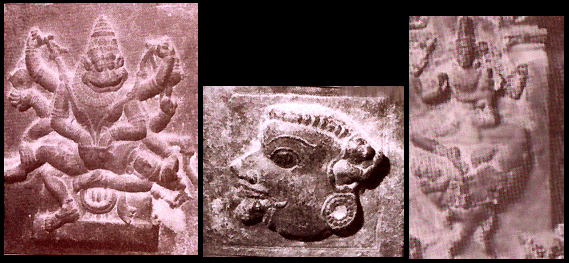
Temple Carvings
Lord Nrsimha (left), Surabai (center), and Ravana (right)
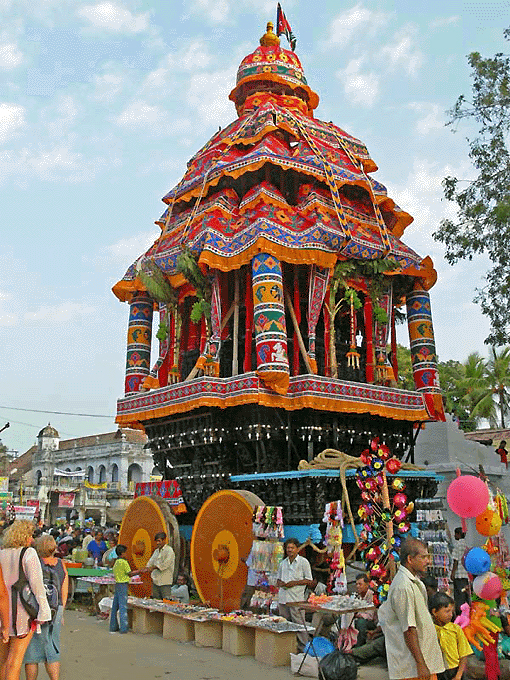
Temple Chariot with Half Decoration
Temple Ratha Chariots
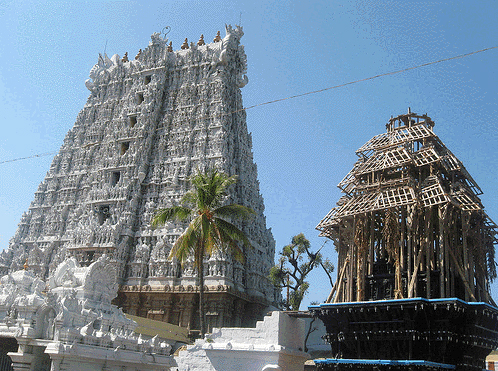
Temple Chariot base after Festival
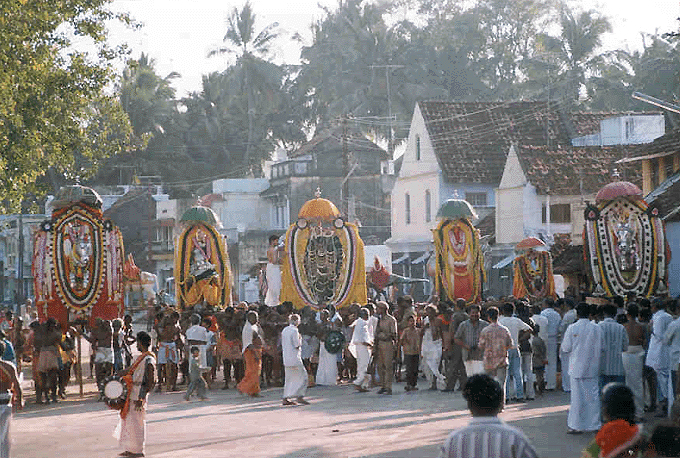
Panja Moorthy Tharisanam
them to a tall dwarapalaka sculpted in stone. He takes a thin stem of a coconut leaf and
threads it right through from one ear to the other. It highlights the artistic excellence of the
sculptor who created it. The dwarapalaka does not listen to these trivialities. His job is only to
guard the entrance.
For you are immediately drawn to the fleet of exquisitely carved, wooden temple cars standing
sentinel around the temple. A couple of them are large, massive even, and look like they’ve
rolled in from another, timeless world. And perhaps they have, for they carry the gods during the
temple’s annual festival in December.
Outside, there is an excellent collection of paintings found on the walls of the temple gopuram,
which are now the aim of restoration and protection from local vandals. The approximately 115
paintings on the seven tiers of the tower are 120 years old, drawn onto the limestone walls
using herbal extracts. Sometime after 1888, two kumbabhishekams (baths for the building)
were performed, but no attempt was made to restore the paintings, but it is hoped will now
become the focus of serious preservation.
which are now the aim of restoration and protection from local vandals. The approximately 115
paintings on the seven tiers of the tower are 120 years old, drawn onto the limestone walls
using herbal extracts. Sometime after 1888, two kumbabhishekams (baths for the building)
were performed, but no attempt was made to restore the paintings, but it is hoped will now
become the focus of serious preservation.

Temple Carvings
Lord Nrsimha (left), Surabai (center), and Ravana (right)
Another story of note about Suchindram Temple is the age-old practice of Agnipariksha that
was practiced here up until the 1860's, when it was forbidden by the government. This ritual
could only be engaged if the king gave his consent, and then it was done on a designated date.
The ritual involves Kaimukkal, or 'dipping of the hand', in which any Namboothiri, or a high
caste Brahmin who was under threat of excommunication due to immoral behavior, had to prove his innocence.
was practiced here up until the 1860's, when it was forbidden by the government. This ritual
could only be engaged if the king gave his consent, and then it was done on a designated date.
The ritual involves Kaimukkal, or 'dipping of the hand', in which any Namboothiri, or a high
caste Brahmin who was under threat of excommunication due to immoral behavior, had to prove his innocence.
A small silver ox statue was placed in a copper vessel of boiling ghee. The accused Brahmin
had to reach in and pull the figure out of the ghee. A complex ritual followed in which the hand
was bandaged, and the Brahmin taken to the home of a senior man, who watched over him. On
the third day his hand was unwrapped. If the fingers were black and burned, the Brahmin was
excommunicated, and pushed to the fringe of society. If his honor was vindicated, and the hand
was normal, he was returned to his post, given gifts from the king, and all due respects were
given to him by the temple community. One can only imagine the level of integrity required of
Brahmins who faced such a method of oversight.
had to reach in and pull the figure out of the ghee. A complex ritual followed in which the hand
was bandaged, and the Brahmin taken to the home of a senior man, who watched over him. On
the third day his hand was unwrapped. If the fingers were black and burned, the Brahmin was
excommunicated, and pushed to the fringe of society. If his honor was vindicated, and the hand
was normal, he was returned to his post, given gifts from the king, and all due respects were
given to him by the temple community. One can only imagine the level of integrity required of
Brahmins who faced such a method of oversight.

Temple Chariot with Half Decoration
Temple Ratha Chariots
The chariots of Sthanu-Mal-Ayan temple are very beautiful, and the center of attractice at the
annual Car Festival here. The chariots come out at the end of a 10-day festival, which begins
on the day of Sathayam, in the month of Markazhi (December/January). Lakhs of devotees
come to enjoy the festival. Another processional festival is held in Chiththirai (April/May), when
the deities are taken out on the cars to give darshan to the devotees.
annual Car Festival here. The chariots come out at the end of a 10-day festival, which begins
on the day of Sathayam, in the month of Markazhi (December/January). Lakhs of devotees
come to enjoy the festival. Another processional festival is held in Chiththirai (April/May), when
the deities are taken out on the cars to give darshan to the devotees.
While Their Lordships' original temple chariot was destroyed during the invasion of Khan
Chanda Saheb, many devotees sacrificed their lives in protecting the remaining chariots, thus
forcing the invaders to retreat. Afterwards, the Devi (Amman) car was made the major chariot.
Each year it is accompanied by the chariots of Ganesa and Swamy, and each of the chariots
bears one member of the Trimurti.
Chanda Saheb, many devotees sacrificed their lives in protecting the remaining chariots, thus
forcing the invaders to retreat. Afterwards, the Devi (Amman) car was made the major chariot.
Each year it is accompanied by the chariots of Ganesa and Swamy, and each of the chariots
bears one member of the Trimurti.

Temple Chariot base after Festival
The chariot is made of wood and is carved with beautifully detailed sculptures, many of which
feature the pastimes of Krishna and Rama lila. Each year, the upper portion of the car is
remade with fresh poles and fabrics, and taken out on procession.
feature the pastimes of Krishna and Rama lila. Each year, the upper portion of the car is
remade with fresh poles and fabrics, and taken out on procession.

Panja Moorthy Tharisanam
To See the Another post related this then click on the below link:-(PHOTO)
To see the related post to this then click the link shown below:- (VIDEOS)
Suchindram temple - Video
Suchindram temple - Video
To See the Another post related this then click on the below link:-(Journey Experience)
Mathur Hanging Bridge - Journey Experience
Mathur Hanging Bridge - Journey Experience
Courtesy:-http://sankarrad.blogspot.in/2010/06/where-trinity-rules.html
http://www.harekrsna.com/sun/features/09-09/features1504.htm


A very informative post of the Thanumalayan temple, Suchindram. It is an important Hindu temple of importance to both Shaivaite and Vaishnavite sects of Hinduism. The temple is famous for its sculptures. Check the Suchindram temple timings before visiting the temple.
ReplyDelete